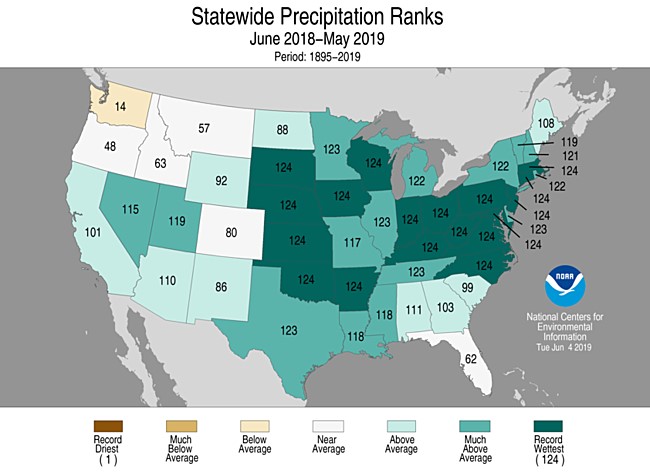posted
on Monday, August 5, 2019
in
Water and Land Newsby
As we start to feel the effects of climate change, Iowa will see increased flooding and droughts. This year, Iowa has yet again seen record-breaking flooding. From June 2018 to May 2019, the state saw more than 50 inches of rain, the wettest 12 month period on record since official records began in 1895.
With increased precipitation and flooding, cities and towns around the state have been grappling with how to move forward. But it wasn’t just in Iowa – the trend was seen all across the United States.

The U.S. experienced the wettest 12-month period on record. Image courtesy of NOAA.
Davenport, Iowa has had a long and complicated relationship with flooding. While frequently impacted by high water, the city has long since avoided installing a flood wall. A recent Iowa Public Radio article notes that National Weather Service Climatologists are urging the city consider the impacts of climate change in their flood plans.
Yet, the city's identity is intertwined with the river. Building a wall to shut it out doesn't feel right to much of the community. Mayor Frank Klipsch told the Des Moines Register, "It's a balance of those things and our commitment, as a community, to say we're not going to put up something that keeps water out of Davenport but also permanently changes the look of our riverfront." With increases in snowfall and rain, flooding is only going to get worse.
Other options exist for Davenport. Currently, the city relies on a containment system that includes a 305-acre wetland and a wide strip of grass. When the water crests higher than what the wetland can handle, temporary barriers, such as sandbags, are used to help block water. The current system could be expanded, but some critics note that it would require a significant amount of land and could be unreliable. While building a flood wall is an option, so is expanding on the existing containment system.
Since 2008, Davenport has experienced seven of its 15 biggest floods. The most recent flood was estimated to cause $30 million in lost revenue and damages. While the state has done a lot for flood prevention, we still have work to do be done.
Natural flood barriers like buffer strips, bioreactors, saturated buffers, and wetlands help minimize flooding while also improving water quality. As our state begins to grapple with these issues, we can tackle our nutrient pollution problems at the same time as we minimize our flooding.
- Grace Holbrook
IEC Water Program
- climate change
- flooding
- resiliency
- riparian buffers